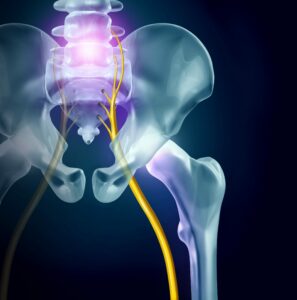5 Frequently Asked Questions about Sciatica
5 Frequently Asked Questions about Sciatica
Published: September 16, 2019
5 Frequently Asked Questions about Sciatica
Sciatica is one of the most prevalent—and most misunderstood—types of pain, and it affects millions of Americans each year. Studies suggest that as many as 40 percent of people will experience sciatica symptoms in their lifetime, and your chances of experiencing it increase with age. If you suspect that you’re suffering from sciatica or if you’ve recently been given a diagnosis, you may be wondering what the causes and treatments are for this condition. You may also be wondering, “How should I find the right pain specialist near me?” Fortunately, our Texas pain specialists in San Antonio are here to answer 5 frequently asked questions about sciatica. Read on to learn more, and to discover your options for sciatica pain relief.
-
What is Sciatica?
Sciatica is the name given to pain that is caused when the sciatic nerve is injured or irritated.
The sciatic nerve is the longest nerve in the human body, starting in the lower back and then splitting to run through the hips, buttocks, legs, and feet. Because of this, whenever bone spurs or spinal stenosis occur and put pressure on the sciatic nerve in the lower back, the result can be problems or pain all the way down the sciatic nerve.

-
What are the Symptoms of Sciatica?
Sciatica is most often characterized by pain that radiates from the lower back into the back or side of the legs. This pain can range from mild aches to sharp or severe pains. Some sufferers will also experience tingling, weakness, or numbness in the leg or foot.
-
What Causes Sciatica?
Many different conditions can cause or contribute to sciatica pain. Common causes of sciatica include herniated discs, osteoarthritis, trauma to vertebrae resulting in compressed nerve fibers, back injuries, degenerative disc disease, pregnancy, and more.
Other factors that can worsen sciatica pain (or increase the likelihood of a person developing sciatica pain) include being overweight, lack of regular exercise, frequently wearing high heeled shoes, sitting for prolonged periods, occupations involving hard physical labor, or sleeping on unsupportive mattresses.
-
How is Sciatica Treated?
Because sciatica does not have one single cause, there is no one treatment that works for every person with sciatica. In less-severe cases, sciatica pain may respond to over the counter pain medications such as acetaminophen, aspirin, or NSAIDS. Exercise has also been shown to help some sciatica sufferers. More severe cases may require prescription muscle relaxants, prescription pain medications, or even antidepressants. Steroidal injections and physical therapy have also been proven to help sciatica sufferers in many cases.
-
How Do I Find a Pain Specialist Near Me Who Offers Sciatica Treatment and Relief?
If you live in San Antonio and are currently living with chronic pain, the specialists at the office of Dr. Raul Martinez want to help. We can determine the extent of your sciatica, identify the source of your pain, and develop a unique treatment plan that is customized for you. Dr. Raul Martinez and his team of experienced physicians have helped thousands of chronic pain sufferers, and are committed to providing patients with the very best in pain management treatment. We believe that although pain is inevitable, suffering is optional—and we want to help you regain control of your life.
So now that you know the answers to 5 frequently asked questions about sciatica, you may be wondering how to learn more about possible treatment options for this condition. If so, visit us online or schedule an appointment with one of our physicians today.
[rev_slider alias=”blogbutton2″][/rev_slider]
